How To Travel With Your Dog

Stud Tail In Dogs

Stud tail in dogs is due to hyperplasia of the oil (sebaceous) glands on the dog’s tail. While intact males are most often affected, hence the name “stud tail,” it can occur in dogs of both sexes, including dogs who are spayed or neutered. There is speculation that this gland may produce some sex-related scents. This is based on the “violet gland” in foxes. Some dog breeders use that term as well, but no one seems to describe any associated odor as smelling like violets!
Causes of Stud Tail in Dogs
Most commonly, stud tail is caused by excess hormones, usually androgenic ones. This tail gland hyperplasia could be due to simple excess testosterone, adrenal gland hormones influenced by Cushing’s syndrome, or any tumor that causes hormone production. Other causes include:
- Hypothyroidism (low levels of the thyroid hormones)
- Seborrhea, although usually more areas than just the tail have blocked hair follicles and greasy skin
- Another skin disorder that influences the hair growth cycle
What Does Stud Tail in Dogs Look Like?
What you see is a funky area partway down your dog’s tail, close to the base. It may look swollen or simply greasy and discolored. There is usually some hair loss. Rarely, there will be an off odor. The area may be pigmented and feel bumpy.
It is more noticeable in dogs with short- or medium-length haircoats. Labrador Retrievers, Akitas, and German Shepherds seem to have a higher risk of this problem but that is anecdotal.
Complications of Stud Tail in Dogs
Most dogs blissfully ignore the area, but if your dog gets a secondary infection, you might notice him licking, chewing, or rubbing his tail. Inflamed, red skin, discharge, and even draining tracts may develop with an infection (usually bacterial).
Treatment of Stud Tail in Dogs
Your veterinarian will likely do a cytology and check for possible tumors or hormonal imbalances. If indicated, a needle aspirate or a punch biopsy to rule out any type of neoplasia may be done.
Mild cases without obvious infection generally respond to home care, such as cleaning the area with an anti-seborrhea shampoo or wipes with benzoyl peroxide or chlorhexidine. This cleaning may need to be done two or three times a week. Trimming the hairs around the area can make it easier to keep it clean.
If infection is present, antibiotic ointment or oral medications may be needed.
If your dog is intensely licking or chewing an Elizabethan collar can help speed healing by preventing the dog from reaching the area.
If your dog has an underlying condition such as Cushing’s disease or hypothyroidism, that problem needs to be treated.
Can You Prevent Stud Tail in Dogs?
Not really. Sometimes owners will elect for castration if their dog is intact. It will take a couple of weeks for all the signs to resolve after neutering as hormone levels drop, bit this may not clear the problem.
Fortunately, for most dogs, stud tail is a benign, cosmetic problem, which means keeping the area clean may be all that your dog needs.
Best Toys for Puppies
Chewing is a normal part of puppy development. Unlike humans, who have hands, curious puppies explore their surroundings with their mouths. They also begin teething around 3 months of age, where they lose their baby teeth and adult teeth begin to emerge, causing sore gums and a strong urge to chew. Providing appropriate toys for chewing and mental stimulation is essential for puppies to help soothe discomfort and prevent destructive chewing on household items like furniture legs, electrical cords, and shoes.
What Is a Good Teething Toy for Puppies?
A good teething toy should be safe, durable, and appropriately sized for your puppy’s breed and age. Soft but resilient materials, such as rubber, nylon, or silicon, are ideal for massaging sore gums without damaging new teeth. Textured surfaces such as small nubs and ridges can help maintain interest in the chews and allow the puppy to exhibit different chewing behaviors such as pulling and cobbing. Toys that can be chilled in the refrigerator are helpful for soothing gum inflammation and puzzle toys can help keep puppies stimulated and out of trouble.
Fortunately for this review, and unfortunately for my sanity, I had not one, but two puppies to test the following teething and puzzle toys out on! I have two young smooth-coated Collies: Merlin, who is now 1 year old, and Flick, who is 6 months old. These toys have been tested out for several months, and the verdict is in. We tested out six types of teething toys and three enrichment toys to help you pick the best option for your pups!
Overall Best Puppy Toy and Best Puppy Teething Toy:
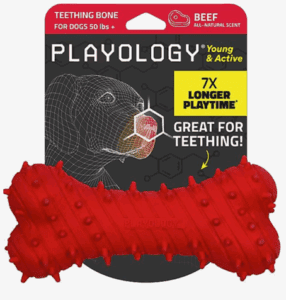
Playology Young & Active Teething Bone
$19.99
Made in China
Scents: Beef, Chicken, Peanut Butter
This was a total puppy favorite. This toy is scented, a soft rubber, durable, and textured just right. The solid-cast nubs help sooth sore gums, and the texture and scent help keeps pups engaged. This toy touts a seven-times longer playtime due to the added scent, which I was skeptical about at first, but now I am sold on its benefits. This toy is easy to rinse off and clean, perfect for moderate to heavy chewers, and only shows some minor wear after four months!
This is the puppy’s favorite teething toy, and it is still their primary go-to months later! I will not bring a puppy home in the future without one of these in the house.
Best Puppy Tug Toy:

Nylabone Puppy Teeth ‘n Tug Toy
$13.19
Made in China
This toy was great for the puppies to play together with, and this is a toy they pick up to play with often. I do like it and would buy it again, however I wish I had sized up, as I got the toy for the size they were when they were much younger, and this is still a toy they like as much bigger dogs. This toy does not show any sign of wear, even after multiple vigorous tug and chew sessions.
Best Freezable Puppy Teething Toy:
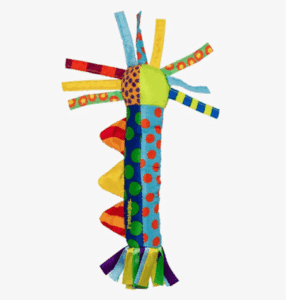
$4.99
Made in China
This toy is designed to be wet and frozen for icy-relief! This is a great option for small dogs who are light chewers, but it is too small for larger breed puppies. This is a very soft toy, when it is not frozen, but my puppies did like all the little fabric tassles and were interested in chewing it.
Best Puppy Teething Stick:
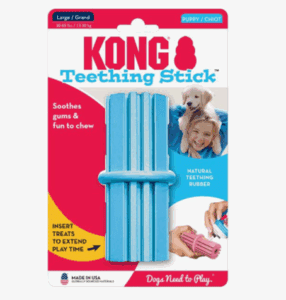
$13.99
Made in USA
This soft rubber toy has ridges that can be filled with treats, wet food, peanut butter, pumpkin, or yogurt for extra, and sometimes messy, fun! I liked freezing some sort of wet treat in the grooves to make it last longer and help sooth their sore mouths. My biggest complaint is that it can be challenging to clean. This was not the puppy’s first pick for chewing, unless it had food involved, but it is one they grab from time-to-time.
Best Puppy Toy for Power Chewer:
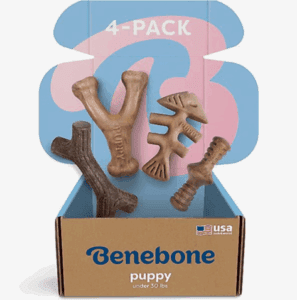
Benebone Tough Puppy Chew Multipack
$24.95 (4-pack)
Made in USA
We have lots of Benebones lying about the house and they have been a great, reliable chew for all my dogs, not just the puppies. However, they are very hard, and they can pose a risk for fractured teeth. They are also incredibly painful to step-on in the night—be warned. These toys are the only ones that I think would stand up against a power-chewer and the flavor in the chew keeps my dogs coming back for more!
Best Puppy Teething Toy for Enrichment:

$12.69
Made in China
This toy is stuffable and freezable to keep your pup entertained. I do find this toy much easier to clean compared to the KONG Teething Stick. Similar to the KONG, this was not a toy that I found the puppies grabbing often to chew on without added food for incentive, but it is one that is nice to have on hand for treat enrichment!
Best Puppy Snuffle Mat:
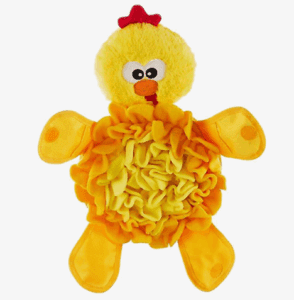
Nina Ottosson Snuffle Palz Bird
$15.99
Made in Cambodia
This snuffle mat is nice because it can be made more challenging by closing the Velcro arms. I love snuffle mats for puppies as it helps tire out their brains by making them problem-solve and use their noses to find the hidden food. This snuffle mat can be machine-washed, however, I do wish it was bigger. Be sure to supervise your puppy as chewing or ripping up the snuffle mat may be an attractive option, especially for frustrated pups!
Best Puppy Puzzle Toy:

Outward Hound Puppy Lickin’ Layers Puzzle Feeder
$15.99
Made in Vietnam
This is a 3-in-1 lick mat, slow feeder, and puzzle feeder that features three layers of fun! Puppies have to spin, lick, and sniff through this slow-feeding puzzle. This toy is dishwasher safe and BPA free. While I absolutely love this toy/feeder combo, I would recommend sizing up to the normal size Lickin’ Layers bowl (for adult dogs) for larger breeds as the puppy version is quite small and can only hold about a half cup of food.
Best Slow-Feeding Puppy Toy:

$10.99
Made in China
This toy is fantastic for enrichment and slow feeding. There is a bit of a learning curve, but the ball can be adjusted to increase or decrease the flow of treats to make it more or less challenging. A word of warning, this is a LOUD toy, especially on hard floors and with kibble. If noise is an issue, I would recommend using it on a carpet and opting for a softer treat to fill it.
The right toys can make the many stages of puppyhood far more fun and comfortable for both puppies and their owners. Look for safe, appropriately sized options to encourage healthy chewing and structured play. Be sure to match the toy with your puppy’s chewing strength, check toys frequently for damage, and replace toys when worn. The expense of a replacement toy is always going to be less than a trip to the emergency vet! Hopefully, this review helps you find the perfect match for your puppy at home.
Can Dogs Have Tums?
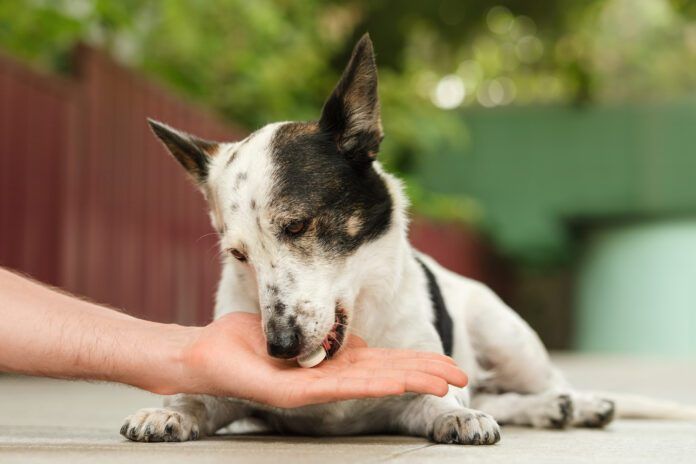
Tums is an over-the-counter (OTC) human antacid composed of calcium carbonate. If your dog is battling stomach issues, your veterinarian may recommend an antacid for dogs to help with high levels of stomach acid, but it’s not likely to be Tums. Most commonly, your vet may prescribe an acid blocker such as famotidine (Pepcid) or omeprazole (Prilosec).
Tums for Dogs with Kidney Failure
For dogs with kidney failure, phosphorus buildup can be a serious side effect. Veterinarians usually prescribe phosphorus binders to deal with this, but Tums may be suggested as a low-cost alternative. The calcium in Tums helps to bind some of the excess phosphorus, which is then passed in the feces. This is not the ideal, however, and dosing directions need to be followed exactly. You should be in close contact with your veterinarian.
The use of Tums long-term without veterinary supervision can exacerbate kidney disease and/or cause an excess of calcium. Tums can also interfere with some other medications, generally making them less effective. You should always check with your veterinarian before trying any OTC medication for a dog with chronic health problems.
When to Consider Tums for Dogs
The most common use for Tums in dogs is for calcium supplementation for female dogs after giving birth (whelping). Tums should not be given during pregnancy or pre-whelping as it can lead to life-threatening hypocalcemia levels, problems during whelping, and problems during lactation if given pre-whelp.
Eclampsia, milk fever, or hypocalcemia can be seen in dams who are nursing. It is most common with large litters and with dams who were inappropriately supplemented with calcium while pregnant. Affected bitches may show muscle tremors and progress to seizures. Behavior changes may be the first subtle indication that something is wrong.
This is a medical emergency, usually requiring intravenous calcium. Post hospital care, bitches may be sent home with Tums as one of their sources of follow-up calcium supplementation. Directions should be followed exactly.
If Tums are suggested for calcium supplementation for your bitch post whelping, be sure to get an appropriate dose from your veterinarian. Check for the addition of flavorings like xylitol and for any dyes.
Remember, xylitol can be deadly to dogs, even in small amounts! Read the label ingredients. In addition, Tums preparations often have dyes added to make them appeal to people. Some dogs are sensitive to these food dyes to provide color.
Note: Tums is not approved for use in dogs but might be used off label for some dogs. Off label means the medication is not FDA approved for that use but generally regarded as safe for certain uses in pets under controlled conditions.
The Best Canned Dog Foods

There are many reasons dog owners may choose to feed their dogs canned food, and one primary concern that leads many others to choose not to—the price. High-quality canned foods, especially those rich in animal protein and made with whole ingredients, are often significantly more expensive than dry foods. For those who own large-breed dogs, or for multi-dog households, the expense of feeding canned food exclusively adds up very quickly, making it cost-prohibitive for many families, including my own. However, for certain dogs, the benefits may justify the extra expense.
The biggest advantage of canned food is its high moisture content. With most formulas containing between 75-85% water, a canned diet is an excellent way to boost your dog’s hydration. This makes canned food especially beneficial for dogs with kidney or urinary tract issues, those on diuretic medications, and dogs recovering from gastrointestinal illnesses. Proper hydration supports healing, organ health, digestion, and overall vitality.
Another major benefit of canned diets is their composition. Many high-quality canned foods are naturally lower in carbohydrates (with some being carb-free) while also being rich in animal protein and healthy fats. Because dogs have no nutritional requirement for carbohydrates, this balance is ideal for maintaining lean muscle and supporting metabolic health. In particular, low-carbohydrate diets may be advantageous for dogs with cancer, since cancerous cells use carbohydrates, glucose to be specific, as an energy source at a higher rate than most normal cells in the body. Because of this, you want to feed your cancer-patient as few carbs as possible.
Wet food is also typically more aromatic and palatable than dry food options, making it ideal for picky eaters, dogs with decreased appetites due to illness or medication, and senior dogs who have a reduced sense of smell. Many canned diets also utilize fewer preservatives and contain higher levels of animal-based ingredients. The soft texture of canned food also means it can be used to fill enrichment toys, lick mats, or puzzle feeders to provide both mental stimulation as well as a tasty and nutritious snack.
(Note: Affiliate links are offered for your convenience. Whole Dog Journal is reader-supported. If you purchase food through links on our site we may earn a commission. Whole Dog Journal does not accept money for its food and product reviews.)
Best Canned Dog Food by Category
If you are considering a wet-food diet, it is important to select the right product for your dog’s specific needs. The store shelves are full of options, and shopping online can be equally as overwhelming for even the most informed pet parent. To help make choosing a diet that is right for your dog easier, we have selected products we recommend under the following categories:
- Best Adult Maintenance Canned Dog Food
- Best All-Life Stages/Growth Canned Dog Food
- Best Limited Ingredient Canned Dog Food
- Best Grain-Free Canned Dog Food
- Best Lower Fat Canned Dog Food
- Best High Protein Canned Dog Food
- Best Vegetarian Canned Dog Food
- Best Budget Friendly Canned Dog Food
- Search Our Dog Food Database
Many adult dogs thrive on an adult-maintenance diet, which generally contains a lower concentration of fat and protein, and a few other nutrients, compared to diets formulated for puppies. Growing puppies and pregnant or lactating females require an “all life stages” food and many highly active dogs do very well on these diets as well, as the higher fat and protein levels help to support sustained energy and lean muscle mass.
Beyond these two basic categories, your dog may require a limited-ingredient or grain-free diet, or one with lower amounts of fat or higher amounts of protein due to food sensitivities or health issues. We also have selected options for a diet that does not contain meat, and some budget-friendly options too!
Best Adult Maintenance Canned Dog Food
Merrick Adult Grain-Free Beef, Lamb & Bison Pate
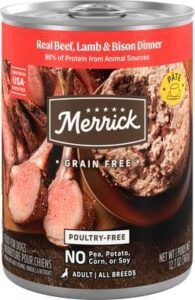
Things we like:
- Meat focused recipe with no carbs
- Made in USA
First 10 ingredients: Deboned Beef, Beef Broth, Beef Liver, Deboned Lamb, Deboned Bison, Natural Flavor, Salmon Oil, Salt, Tricalcium Phosphate, Locust Bean Gum
- Protein: Min 9%
- Fat: 5%
- Calories: 399 Kcal/can
- Cost: $0.30/oz
Runners up:
Best All-Life Stages/Growth Canned Dog Food
The Honest Kitchen’s Butcher Block Turkey & Autumn Veggies Pâté
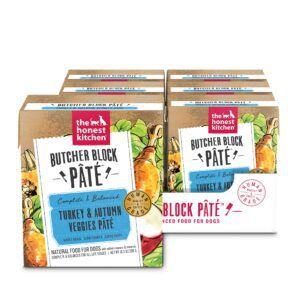
Things we like:
- Human grade
- Single-species source of animal protein
- Legume-free
First 10 ingredients: Turkey, Turkey Bone Broth, Turkey Liver, Spinach, Apples, Carrots, Brown Rice, Pumpkin, Agar Agar, Minerals
- Protein: Min 10.5%
- Fat: 5.5%
- Calories: 366 Kcal/10.5-oz box
- Cost: $0.38/oz
Runners up:
- BIXBI Liberty Surf ‘n Turf Ocean Whitefish, Beef, and Beef Liver
- Lucy Kettle Creations Chicken Recipe in Gravy
Best Limited Ingredient Canned Dog Food
Evanger’s Hand-Packed Whole Sardines
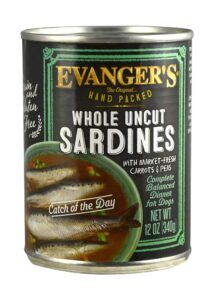
Things we like:
- Very limited ingredient formula with only one animal source
- No gums
- “All life stages” food
- Also comes in Braised Beef Chunks and Chicken Drumette formulas for alternative proteins
First 10 ingredients: Sardines, Water Sufficient for processing, Carrots, Peas, Vitamins, Minerals.
- Protein: Min 8%
- Fat: 4%
- Calories: 328 Kcal/can
- Cost: $0.35/oz
Runners up:
- Dave’s 95% Premium Meats Beef & Beef Liver
- American Journey Limited Ingredient Diet Duck Recipe
- Zignature Venison Limited Ingredient Formula
Best Grain-Free Canned Dog Food
Wellness Complete Health Turkey & Duck Stew
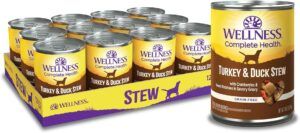
Things we like:
- No reliance on (and typical over-representation of) legumes to replace grain
- Moderate protein and fat levels
First 10 ingredients: Turkey Broth, Turkey, Duck, Cranberries, Turkey Liver, Sweet Potatoes, Dried Egg Product, Turkey Heart, Carrots, Natural Flavor
- Protein: Min 8%
- Fat: 3.5%
- Calories: 344 Kcal/can
- Cost: $0.33/oz
Runners up:
Best Lower Fat Canned Dog Food
Weruva Paw Lickin’ Chicken in Gravy Grain-Free Canned Dog Food
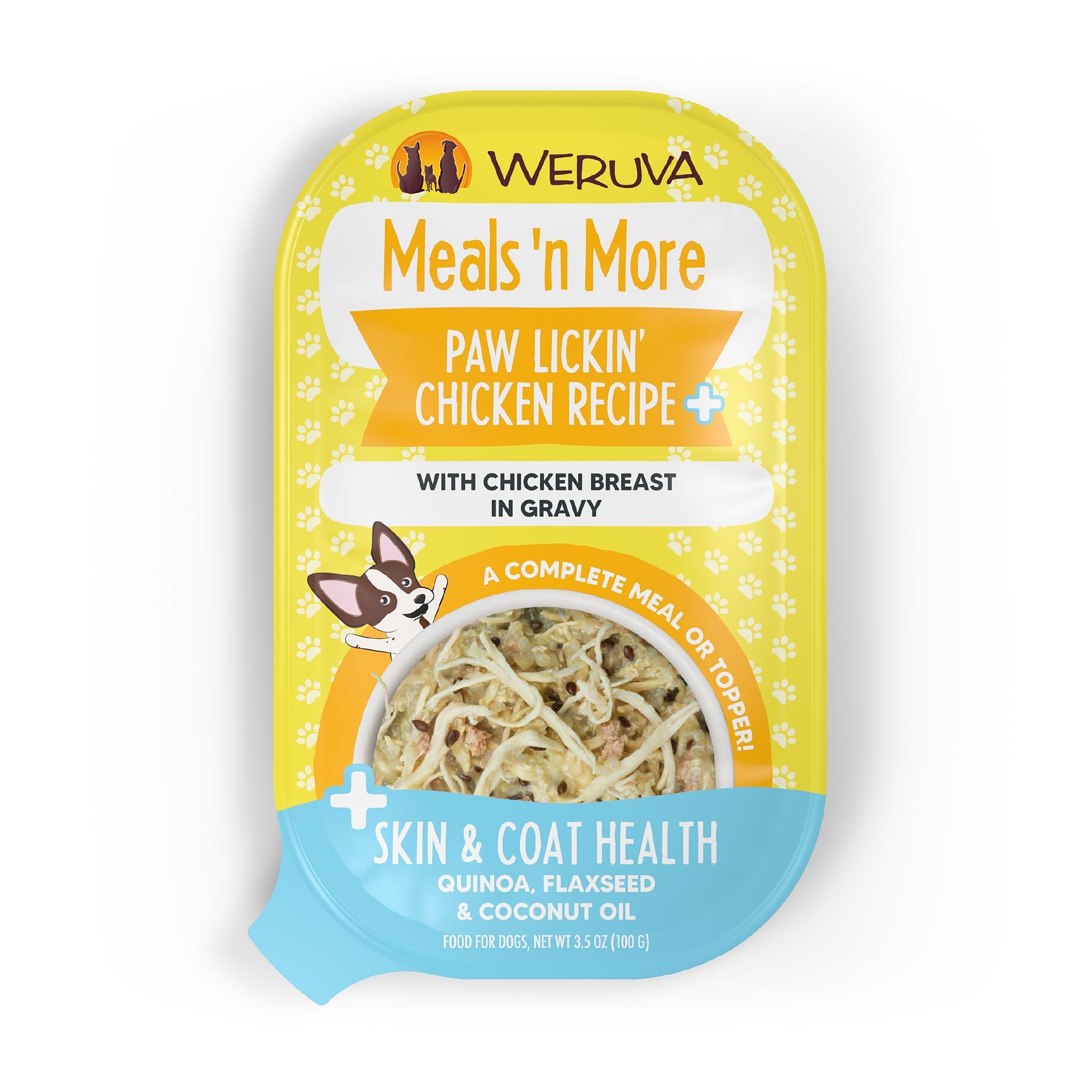
Things we like:
- Meat-first formula
- Legume-free
- High-protein
First 10 ingredients: Chicken (Boneless, Skinless, White Breast), Water Sufficient for Processing, Potato Starch, Sunflower Seed Oil, Tricalcium Phosphate, Xanthan Gum, Choline Chloride, Zinc Sulfate, Vitamin E Supplement, Thiamine Mononitrate (Vitamin B1)
- Protein: Min 10%
- Fat: 1.4%
- Calories: 268 Kcal/can
- Cost: $0.36/oz
Runners up:
- ACANA Premium Chunks Pork in Bone Broth Grain-Free Wet Dog Food (3.0% min fat)
- Nulo Adult Trim Weight Management Grain-Free Turkey & Cod Recipe (3.0% min fat)
- Tiki Dog Meaty High Protein Diet Chicken with Egg Recipe in Broth (2% fat)
- Natural Balance Fat Dogs Chicken & Salmon Recipe (2.5% min fat)
Best High Protein Canned Dog Food
Tiki Dog Meaty High Protein Diet Chicken Recipe in Broth
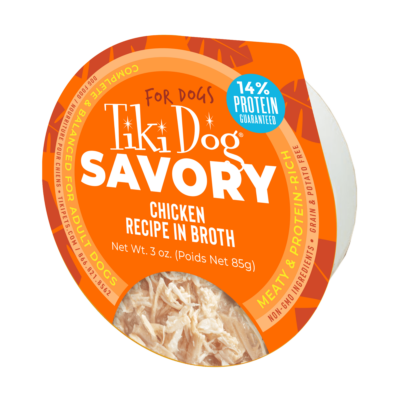
Things we like:
- High protein without high fat content
- Complete and balanced for all life stages
- All protein is from animal origins instead of plant protein
First 10 ingredients: Chicken, Chicken Broth, Sunflower Oil, Calcium Lactate, Dicalcium Phosphate, Xanthan Gum, Potassium Chloride, Salt, Choline Chloride, Magnesium Sulfate
- Protein: Min 14%
- Fat: 2%
- Calories: 74 Kcal/ cup
- Cost: $0.80/oz
Runners up:
- The Honest Kitchen’s Beef, Lamb, & Spring Veggies (13.5% protein)
- American Journey Premium Loaf Beef Recipe Grain-Free Canned Dog Food (9% protein)
Best Vegetarian Canned Dog Food
Evanger’s Complements Vegetarian
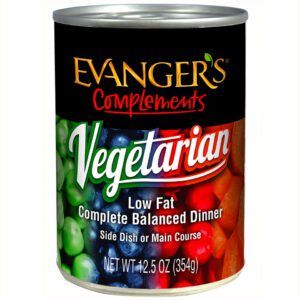
Things we like:
- This food, and its ingredients, are from the USA.
- We prefer non-legume carb sources; our top pick (and our runners up) contains minimal legume ingredients.
First 10 ingredients: Sweet Potatoes, Potatoes, Water Sufficient for Processing, Brown Rice, Carrots, Tomatoes, Organic Olive Oil, Peas, Blueberries, Cranberries
- Protein: Min 7%
- Fat: 2%
- Calories: 276 Kcal/can
- Cost: $0.23/oz
Runners up:
Best Budget Friendly Canned Dog Food
Purina Beyond Beef, Potato, & Green Bean Ground Entrée
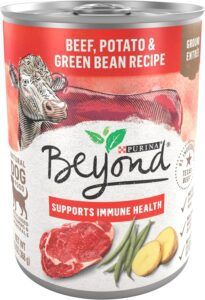
Things we like:
- Very simple formula
- Inexpensive without using meat by-products or food fractions
- Pâté style
First 10 ingredients: Beef, Beef Broth, Chicken, Liver, Potatoes, Green Beans, Guar Gum, Salt, Minerals
- Protein: Min 8%
- Fat: 6%
- Calories: 465 Kcal/ can
- Cost: $0.20/oz
Runners up:
- Chicken Soup for the Soul Classic Chicken & Brown Rice ($0.23/oz)
- Fromm Adult Turkey & Rice Pâté ($0.19/oz)
- Named animal protein sources at the top of the ingredients list. Ingredients in pet food are listed in order of the weight of that ingredient in the formula, so you want to see a named animal protein source or sources in at least one of the top two spots on the list of ingredients. (“Named” means the species is identified: chicken, beef, lamb, etc.)
- Water or broth may be first or second on the list, as the addition of water is often necessary for processing. But the animal protein source or sources should appear immediately after that.
- If plant proteins are present in the food, we like to see them play a supporting role, appearing lower on the ingredient list – no earlier than the fifth or sixth position. The amino acid profiles offered by animal proteins suit dogs better than those of peas, potatoes, corn, soy, etc.
- Named fat sources. Just as with the animal protein sources, any animal fat sources should be identified by species (i.e., chicken fat, beef fat, pork fat, salmon oil, etc.).
- Whole foods. When vegetables, fruits, grains, and/or other carbohydrate sources such as chickpeas, peas, or sweet potatoes are used, to the extent possible, they should be whole.
- Ingredients that have already been processed, shipped, and stored before they are mixed with other ingredients and processed again (canned) lose more of their nutritive value along the way than those that are shipped and stored whole before their inclusion into the wet food mix.
The things we avoid when selecting a diet are:
- Animal products that are not specified by species. Meat, meat meal, poultry, poultry meal, animal fat, poultry fat: If your dog is intolerant of or allergic to certain ingredients, you have to know what specifically you are feeding them.
- Animal by-products. This includes meat by-products and poultry by-product. We would strongly prefer to know what, exactly, is being included in the food, instead of “by-products” being used as a catch-all term. In some cases, the “by-products” used may well be nutritious chicken liver, chicken kidneys, and chicken hearts, but without specific labeling, the composition of the by-product is unknown.
- Ingredient splitting. This is where two or more very similar food “fractions” appear on the ingredients list. Because the ingredients are listed in descending order of their weight, a manufacturer can make it appear that a high-quality ingredient is represented in the food in a greater amount than it is. If all the iterations of an ingredient (to use a common example, brown rice, white rice, brewers rice or yellow peas, green peas, pea protein, etc.) were combined or reconstituted, they would outweigh and push the higher-quality ingredient down on the ingredients list.
- Added sweeteners. Sweeteners are sometimes used in some foods to increase their palatability. In canned foods, the protein- and fat-rich meaty ingredients should be enough to tempt the appetite of any dog.
- Artificial colors, flavors, or preservatives. None of these are needed (or common, thankfully) in canned food.
Ultimately, the “best” diet is one that works for your individual dog, supporting their health, appetite, and lifestyle. While canned food may cost more and require some extra handling, its benefits in hydration, digestibility, and palatability can make it a worthwhile addition, particularly for dogs who need a little extra support at mealtime.
Search Our Canned Dog Food Database
If you’re looking for just the right wet food for your dog, we recommend taking a closer look at our list of “Approved Canned Foods” (available to WDJ subscribers only). This year, in addition to updating our list of more than 1000 individual canned dog foods, we’ve upgraded the database itself. Along with being able to filter your search by company, ingredients, price range, and more, you can also now compare specific foods, keep a list of your favorites, and share your search results with others.
When picking the right diet for your dog, remember that there are no one-size-fits-all recommendations for food. Feed each of your dogs what works best for them and consult with your veterinarian or a nutritionist if you have questions.
The Best Pet Air Purifiers

Join Whole Dog Journal
Already a member?
Click Here to Sign In | Forgot your password? | Activate Web AccessSymptoms and Treatment of Dog Respiratory Illnesses

In recent years, dog flu and severe canine respiratory disease of unverified etiology (causes) have resulted in many illnesses and even deaths in dogs. These two illnesses are part of a group of respiratory problems dubbed the whole canine infectious respiratory disease complex, or “CIRDC.”
Many canine respiratory illnesses are multiple pathogen problems. Often labeled “kennel cough” or “canine cough,” bacterial and viral agents interact together to cause respiratory illness. It’s when these upper respiratory infections develop further into pneumonia that we start to see cases needing hospitalization and some deaths.
Dog Flu Symptoms
Generally, symptoms of a respiratory illness in your dog are like those of the human common cold. For the milder cases, most dogs start off by coughing or sneezing. The classic “kennel cough” cough is a dry, honking sort of cough.
Some dogs may be lethargic and not have their usual appetite or zest for life. Other dogs act just fine even though they have this obnoxious cough. Dogs with chronic health conditions, senior dogs, and puppies are often the most severely affected.
Keep your dog home from day care, play dates, and training classes. Reschedule grooming appointments. All the respiratory pathogens are highly contagious.
Treating Dog Flu
Initial treatment tends to be symptomatic. You want to keep your dog quiet. The more active he is, the more he will cough, and that coughing irritates his trachea and leads to a vicious cycle of more coughing. Switching from a collar to a harness so your dog does not put pressure on his trachea from pulling while walking can also help.
With severe coughing, your veterinarian may suggest anti-cough medication to try to ease the irritation. Setting up a room with a vaporizer or keeping your dog in the bathroom while you shower can help with congestion. We may laugh about the miracle powers of chicken soup as an old wives’ tale, but if your dog will drink some down it does seem to help.
If your dog has ocular discharge or nasal discharge, you need to keep those areas clean. Use a warm compress to loosen any crusts. With any sort of purulent discharge, the likelihood of a secondary bacterial infection—therefore not a pure viral cause—becomes more likely. At that point, antibiotics may be helpful.
If your dog has difficulty breathing, or coughs so much he cannot rest comfortably, you need a veterinary visit. Dogs with pneumonia may need antibiotics, oxygen, intravenous fluids, chest coupage, and nebulization. Testing will be recommended to know exactly which pathogens your dog is dealing with.
What Is Dog Flu?
Flu is an airborne virus that fits with increased cases during winter months. This is especially true where groups of dogs might congregate such as daycare, boarding kennels, dog-sport events, groomers, dog parks, training classes, and veterinary hospitals. Any time an infected dog sneezes, coughs, or barks, they may shed the virus. To make things even trickier, dogs tend to be most likely to shed virus while incubating their infection and before they show full-blown clinical signs. Some dogs will not seem sick but can still shed the virus.
Canine influenza is associated with two flu virus strains: H3N8 and H3N2. H3N8 was first seen in 2004 in Greyhound kennels. The H3N2 variant made headlines with severe illnesses starting in the Chicago area and associated with importations of dogs from South Korea and China from 2015 through 2019. The virus caused big outbreaks with many dogs in one area infected, but it is probably endemic at this time in much of North America. To make matters worse, this is a tough virus that can survive for up to 48 hours on some surfaces, a full day on your clothing or pet bedding, and even 12 hours on your skin.
Atypical Canine Infectious Respiratory Complex (ACIRC)
In late 2022 and early 2023, a new version of canine respiratory illness, ACIRC, appeared. The first cases were in Oregon, Colorado, and New England. Many of these dogs started off with typical relatively mild respiratory signs but more than expected moved on to pneumonia. No definitive pathogen has been identified though an unusual bacterium is on the suspect list. This atypical respiratory disease is still under investigation, although outbreaks have slowed.
What Causes Dog Flu?
The list of potential pathogens for canine respiratory illnesses is a long one as identified by the American Animal Hospital Association:
Viral pathogens
- Canine adenovirus type 2
- Canine distemper virus
- Canine herpesvirus type 1
- Canine parainfluenza virus
- Canine pneumovirus
- Canine respiratory coronavirus
- H3N2 canine influenza virus
- H3N8 canine influenza virus
- Influenza A virus, to detect other
influenza strains
Bacterial pathogens
- Bordetella bronchiseptica
- Mycoplasma species
- Streptococcus zooepidemicus
It is important to remember that many dogs will have more than one culprit, such as Bordetella plus canine adenovirus. Your veterinarian will need to make the call if your dog likely has a viral problem or has some bacteria involved which would respond to antibiotics.
Can You Prevent CIRD?
Obviously, you want to avoid respiratory illness with your dog if possible. Certainly, isolation is one way, but realistically our dogs are going to get some exposure.
Start by vaccinating. The standard distemper/parvo combo usually includes adenovirus and/or parainfluenza virus. Bordetella is given separately. There are injectable, oral, and intranasal versions. Giving the intranasal version can be challenge with some dogs, but I like that it provides some local immunity. So theoretically, local immunity may attack the bacteria right as they get sniffed in. (I suspect I am well protected as well from inhaling droplets that might get flung around when I give it.)
There is a vaccine for canine influenza as well. The injectable vaccine covers both H3N8 and H3N2. Both the canine flu and Bordetella vaccines should be boostered annually.
These respiratory vaccines are considered noncore vaccines. However, if your dog goes to the dog park, groomer, training classes, boarding kennel, or daycare, you would be wise to give these vaccines. Many of these places will require proof of vaccination for these illnesses. My own dogs get these vaccines, timed to give the best boost before the winter indoor activities.
Do Bed Bugs Bite Dogs?

When it comes to bed bugs, humans are the preferred food source, but bed bugs are equal opportunity insects. While bed bugs don’t live on your dog like fleas, preferring to feed and leave, they may inadvertently catch a ride on your dog and/or his bedding. Sadly, flea and tick products are not effective against bed bugs.
Recognize Bed Bug Bites on a Dog
Bed bugs make small, red bites that can be very itchy. At this time, their bites are not associated with any diseases, but if your dog is biting and chewing at the bites, he can develop secondary bacterial or fungal infections.
Some dogs may have an allergic reaction to the bed bug bites and require corticosteroids to treat the reaction while you work to eliminate the bugs.
How to Recognize Bed Bugs
Look for the bugs themselves as well as reddish brown stains under sheets, at mattress corners, and on box springs. One of the best methods for identifying bed bugs is a trained bed bug dog, but most families don’t travel with one.
Bed bugs are flat, brown bugs, about the size of a grain of rice. These bugs become active at night when you and your dog are sleeping. Pet beds, dog crates, and pet blankets can all provide homes for bed bugs. During the day they hide in any cracks related to a bed (frames, headboards, mattress seams). Eggs are also laid in those locations. Bed bugs have five nymph stages, all of whom are blood thirsty.
Startling as it is, adult bed bugs can go months without feeding, so they can live is a closed off room until the unwitting person or pet enters.
Avoiding Bed Bug Infestations
Many people have learned, often the hard way, to check bedbugreports.com when booking a hotel room. Not only will checking save you some itchy bites, but it will also save your dog from bed bug bites.
You can inadvertently bring bed bugs home if you stay in a contaminated place. The bugs can hide in your clothes, your suitcase, your purse, anything you carry out of an infected room and into your home. Bed bugs can, and will, also walk from one room to another such as in a hotel or an apartment building.
Eliminating Bed Bugs
Getting rid of bed bugs is war. Vacuuming, being sure to get into all cracks and crevices, and then dumping the vacuum bag outside in a sealed bag can help. Doing laundry of any possibly contaminated clothes or bedding helps. Be sure to include pet bedding, toys, and blankets. Use hot water for the wash and run the dryer on high heat.
For an infected mattress, enclosing it in an airtight plastic covering will kill the bugs. But, honestly, if you can, get rid of the mattress and buy a new one.
If your house is infected, you will most likely need a EPA-approved pesticide, and you would be wise to use a professional exterminator. Be sure to follow all guidelines on the use of these chemicals. You and all your pets will need to be out of the house.
Avoiding bed bugs is the ideal way to go. Always check hotels, dorms, and cabins before you unload any luggage or supplies.
Chamomile for Dogs
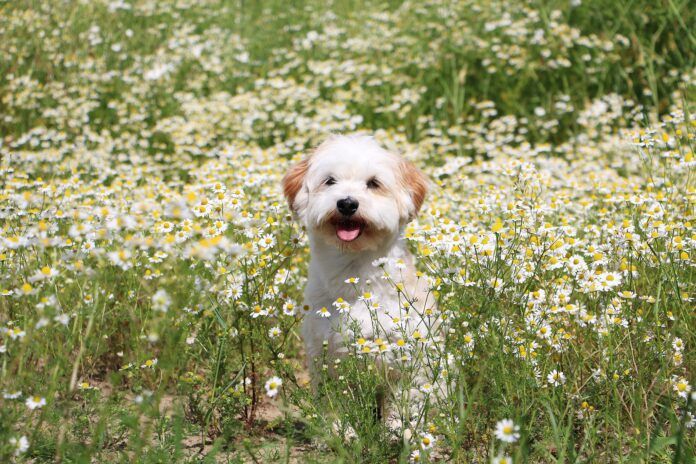
Join Whole Dog Journal
Already a member?
Click Here to Sign In | Forgot your password? | Activate Web AccessThe Best Dog Lick Mats
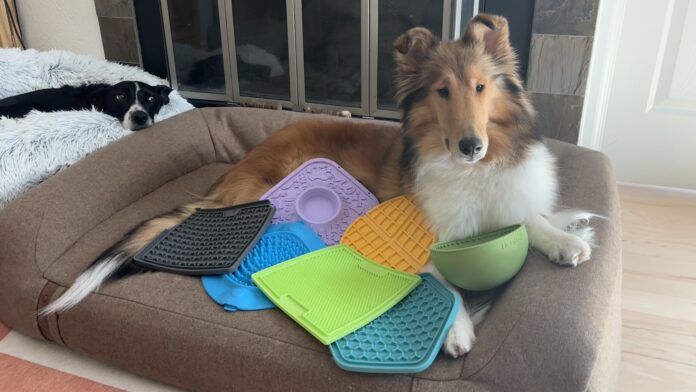
Similar to chewing, licking is a naturally soothing behavior for dogs. The best dog lick mats are excellent ways to offer your dog enrichment in a calming, relaxing way.
Most dog lick mats are made of silicone or rubber and have various crevices or textures, making them ideal vehicles for peanut butter, softened kibble, raw food, or canned food. They can also be frozen to extend mealtimes, which is great for dogs who eat too fast.
A frozen lick mat will slow a dog down significantly more than a slow feeder bowl and won’t cause as much frustration for dogs who have trouble with puzzle toys. These handy tools are also good for dogs who get nervous in certain situations (like at the vet or in the car), since licking has a naturally calming effect.
In addition, lick mats can be great enrichment activities when busy pet parents need to keep their pups occupied occasionally.
Here’s how to choose the best lick mat for your dog:
Traits We Want in a Dog Lick Mat
Ease of use: Dog lick mats should be easy to fill, freeze, and clean. Because lick mats have irregular (and sometimes tiny) patterns, being dishwasher safe is a must. You don’t want to have to hand wash sticky peanut butter or leftover wet food from tiny crevices in a lick mat.
Extra features: Extra features like suction cups to keep the lick mat from moving are handy. Some lick mats also offer additional enrichment though extra features, like wobbling lick bowls for an extra challenge, or waterproof suction mats for bathtime.
Note that some dogs get frustrated with more difficult puzzle toys. Lick mats with lots of compartments or options that wobble may not be suitable for dogs who are easily frustrated. Instead, opt for a lick mat with a single, simple pattern.
Durability: The durability your dog needs will depend on their preferences. Puppies or dogs who tend to chew should avoid lick mats and opt for Kongs or the West Paw Toppl instead. Very small dogs and gentle lickers will likely prefer a softer, more soothing mat, while high-energy excitable dogs may enjoy the extra challenge of a lick mat with deeper, irregular crevices.
Whole Dog Journal is reader-supported. If you purchase through links on our site we may earn a commission. Whole Dog Journal does not accept money for its food and product reviews.
The Best Dog Lick Mats
| Whole Dog Journal Rating | Product and Maker | Price | Size | Notes |
|---|---|---|---|---|
    | LickiMat Classic Soother | $9 | 7.9 x 7.9 x 0.28 inches | The LickiMat classic soother is great at getting dogs to calm down. Less of a puzzle toy and more of a calming activity, the soft bristles and singular pattern reduce frustration and promote decompression. |
   | Woof LickMat | $10 | 8 x 8 x 1 inches | The Woof LickMat is a great suction-backed option, feels sturdy and relatively rigid, and can be used with or without Woof’s innovative LickMix treat. |
   | Frisco Silicone Treat Lick Mat (2 pack) | $14 | 8.86 x 7.99 x 0.39 inches | Though they’re not the most durable option (opt for something else for teething puppies), this two pack of Frisco Lick Mats offers enrichment at an affordable price. |
   | LickiMat Wobble | $19 | 6.3 x 6.3 x 3.5 inches | The LickiMat Wobble is a good option to feed full meals in, since it holds up to four cups of dry kibble (slightly less if soaked). It’s a bit hard to fill with liquid and freeze, since it has a rounded, wobbly bottom. |
   | Spot Belgian Waffle Lick Mat | $8 | 0.3 x 7.75 x 7.75 inches | This waffle-shaped lick mat is divided into four different sections, so you can easily vary the “toppings” or treats you offer to your dog on it. It’s relatively sturdy and thick, so it doesn’t slide around much on the floor. |
   | Aqua Paw Lick Mat | $15 | 8.9 x 8.9 x 0.25 inches | This lick mat is designed to suction to your shower walls so your pup can have a treat during bathtime. It has very deep grooves and requires quite a bit of food to be put in it, which is heavy when frozen and may cause your mat to slide off the wall. |
Best Dog Lick Mat: LickiMat Classic Soother

If the goal of a lick mat is to give your dog a quiet, soothing activity, the LickiMat Classic Soother does a good job of that. It doesn’t have a ton of different textures or compartments and isn’t too difficult for dogs to get the food/treats out of, though it entertains them for quite a long time with its dense bristles.
The pattern on this mat is simple and the texture is soft, encouraging dogs to lick and calm themselves down. It’s great for dogs who get frustrated with puzzle toys or who give up on lick mats with complicated textures.
The big rim around the edge keeps watery treats from spilling out, and it cleaned up easily in the dishwasher.
The only downside to this option (like most lick mats) is that it needs to be placed on something rigid when filling it with liquid if you plan to freeze it. It’s a little bit too floppy to fill with liquid then transfer to the freezer without spilling the filling.
Best Dog Lick Mat with Suction Cups: Woof LickMat

Woof is constantly innovating dog enrichment toys and the new Woof LickMat lives up to the hype. It has a few different uses.
First, you can add water to the brand’s LickMix spread (sold separately) and stir it in the center bowl before spreading it onto the rest of the mat. The mix comes in several different flavors and though the powder can get a little messy during the mixing process, it ultimately doesn’t matter since you’ll be spreading the powder mixed with water all over the mat anyway.
The LickMix spread is convenient since it doesn’t require being put in the freezer. It thickens up on its own after mixing with water and sitting for five minutes.
Secondly, you can simply spread your dog’s favorite treat or wet food onto the mat. Freeze the mat after spreading food on it for an extra challenge.
The mat has a bunch of small suction cups on the back of it, so you can affix it to the floor, the shower wall while giving your dog a bath, or any other hard surface. It can be a little difficult to use the suction cups if the mat is already filled with food (your hands may get a little messy), but it stuck well to my hardwood floors and my bathtub walls. Many lick mats slide around while your dog works on them, so the suction helps it stay in one place.
Best Budget Dog Lick Mats: Frisco Silicone Treat Lick Mat (2 Pack)
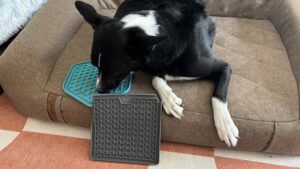
If you have two dogs or like to prep multiple lick mats at a time, the Frisco Silicone Treat Lick Mat 2 pack is the most economical option on this list. I’ve had these two lick mats for years. They’re not the most durable (the gray one has a few nibbles on it from when my Collie was a puppy), but they’re great for trustworthy adult dogs who don’t destroy enrichment toys.
The two different textures both offer long enrichment periods with shallow crevices for your dog to lick their favorite treats out of. Both mats are top rack dishwasher safe, though they sometimes take two wash cycles to get completely clean if you use a sticky treat, like peanut butter, on them.
The only other downside to these mats is that I wish they were a little more rigid. Since they’re floppy, it’s hard to put them in the freezer with liquids on them without spilling.
Best Dog Lick Bowl: LickiMat Wobble
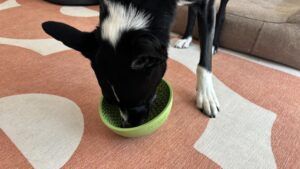
For smart, high-energy dogs or dogs who eat their meals way too fast, the LickiMat Wobble bowl is a great way to slow down mealtime. It holds about 4 cups of dry kibble—less if it’s soaked since it expands—and can be filled with liquid like water or dog-safe chicken broth and frozen.
With frozen soaked kibble and water, it took my dogs nearly an hour to finish their food in this LickiMat, buying me some much-needed quiet time to take a few work calls.
The only downside of this option is that it’s a little bit difficult to fill and freeze since it has a rounded, wobbly bottom. I put it inside of a slightly bigger bowl to keep it stable while I filled it, then put the bowl and the LickiMat in the freezer together.
Another Good Dog Lick Mat Option: Spot Belgian Waffle Lick Mat

The Spot Belgian Waffle Lick Mat is a great divided option. The four different sections can be filled with a variety of treats, foods, or supplements to keep mealtime fun for your pup.
It’s sturdy and rigid, but the sharp square corners of this mat tend to hold onto wet food and peanut butter, even when put in the dishwasher. It may require multiple washes to get fully clean if you use sticky or thick fillings.
This mat is a bit heavier and more rigid than other options on this list, so it doesn’t move as much when dogs are working on it, even though it doesn’t have suction cups.
Best Lick Mat for Bath Time: Aqua Paw Lick Mat

I used to use the Aqua Paw Lick Mat frequently while giving my Collie a bath when she was a puppy. The suction cups are a great idea to make bath time more enjoyable for dogs and this lick mat sticks well to most shower walls and bathtubs (it can also be affixed to the ground for non-bath usage).
The main downside of this option is that it’s very large (opt for the smaller size for small dogs) and requires a lot of food to be put in it since the grooves are so deep. When frozen, it’s very heavy and during testing, sometimes slid off the shower wall from the weight. This is another option that requires multiple cycles in the dishwasher to get completely clean.
Finding the Right Joint Pain Relief for Your Dog
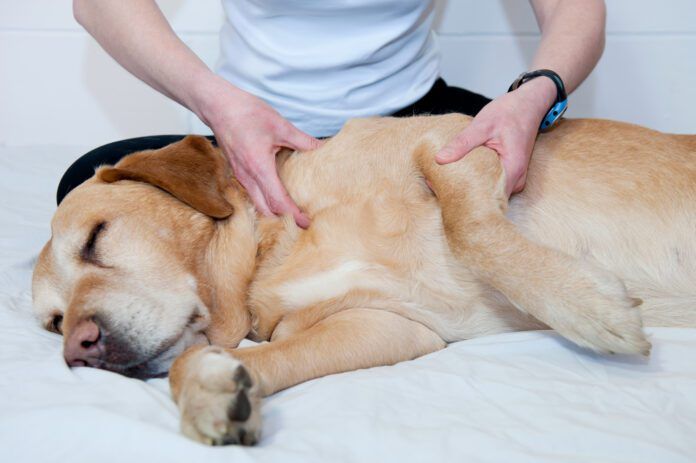
Join Whole Dog Journal
Already a member?
Click Here to Sign In | Forgot your password? | Activate Web AccessWhy is My Dog Foaming at the Mouth?

Most causes of a dog foaming at the mouth are not concerning. Consider what your dog has been doing, his current body language and attitude, and if he has any signs of injury or illness to discover the cause.
Often a dog foaming at the mouth happens simply because they are excited, stressed, or have been exercising heavily. But if your dog seems unwell, it could be something more serious.
Aerated Drool
Dog saliva is usually flat, but panting can add little air bubbles to the drool. This is what causes the appearance of foam! Air can get into your dog’s drool for many different reasons:
- Panting or breathing rapidly from excitement
- Sniffing heavily while also drooling (especially for male dogs sniffing a female dog’s urine)
- Panting due to stress or anxiety
- Panting heavily after exercising or playing hard
- Ate something that tasted bad
If your dog is foaming at the mouth but acting normally, one of these causes is often the reason.
Nausea
If your dog feels a bit pukey, he will likely drool more than usual. This drool can become aerated with tiny bubbles, making it look like foam.
Young dogs frequently experience car sickness, and will be nauseous, drooly, and foam at the mouth when riding in the car. Thankfully most puppies grow out of this. To help your dog, try different methods of riding in the car: crate versus harness with seatbelt, able to see out the windows versus covered to block the view. Your veterinarian can prescribe meds for persistent or severe motion sickness in dogs.
Health Causes of Dog Foaming at Mouth
Several health conditions can cause excessive drooling and resultant foaming at the mouth. Dogs with an underlying issue causing the foaming will likely have additional symptoms.
- Heat stress or heat stroke
- Nausea from a viral, bacterial, or metabolic illness
- Dental disease and pain in the mouth
- Object stuck in the mouth
- Consumed a toxic substance
- Bloat
- Rabies
Heat stress can occur when a dog overheats, usually from being too active in hot conditions or not having adequate ventilation and water availability. If you suspect heat stress in your dog, move him to shade, apply water to his head, underside, and paws, and seek veterinary care immediately.
Many infections and illnesses can cause nausea. Exact symptoms will vary, but can include poor appetite, vomiting, diarrhea, lethargy, and weight loss. Schedule a vet appointment to get a diagnosis.
Dogs with dental disease often drool to try to soothe his mouth. Antibiotics can help, but the best solution is often a dental cleaning under anesthesia to get the teeth and mouth fully cleaned up.
If something is stuck in your dog’s mouth, he may paw at or rub his face and may gag. Gently remove the item if your dog will let you, but some dogs may require sedation to free a stuck object.
Many toxins cause nausea. If you know or suspect your dog has consumed a toxic substance, call a pet poison hotline immediately to find out the best course of action.
A word on toads: many toads cause dogs to foam at the mouth if the dog licks them. Know what toads are in your area, and if they are generally safe or can be toxic. Rinsing your dog’s mouth with water is often helpful.
Bloat is when the dog’s stomach swells and fills with air, possibly also twisting and cutting off blood supply. This is an emergency that may require surgery.
Rabies virus is a worldwide problem and is fatal. This is why rabies vaccination is so important to keep you and your pets safe. If your dog is up to date on his rabies vaccination, it is extremely unlikely that his foamy mouth is due to rabies infection.



